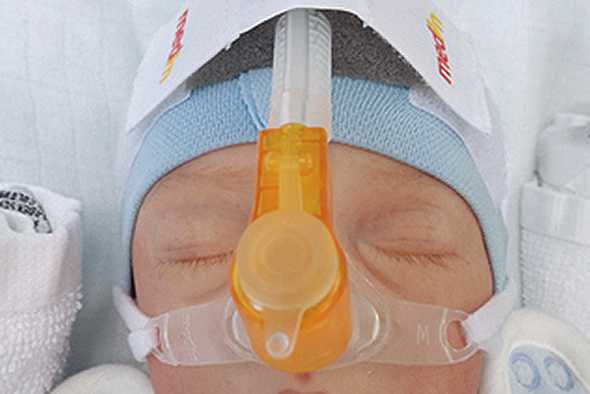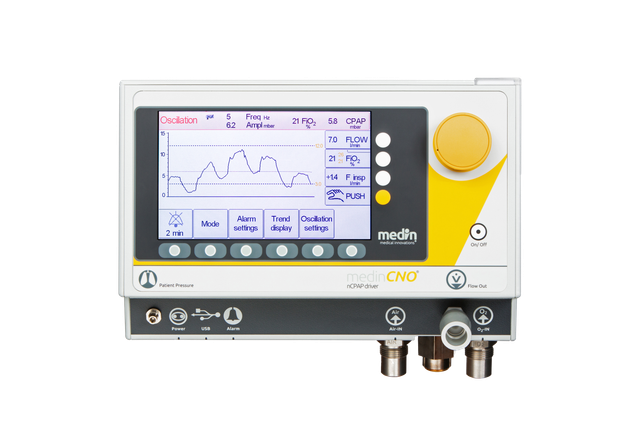
El modo nHFV combina las ventajas de la ventilación de alta frecuencia y el soporte con CPAP no invasivo (
Otra ventaja de la CPAP es el importante efecto ventilatorio que ofrece la ventilación de alta frecuencia. Mientras que en los modos convencionales, como NIPPV, se utilizan valores de presión máxima y se modifican los valores de volumen objetivo para eliminar el dióxido de carbono, en la nHFV, este efecto se consigue mediante la aplicación de oscilaciones de alta frecuencia. El paciente no está expuesto a ventilación obligatoria. Además, no se requiere ninguna sincronización.
Lavado de CO2 eficaz
No se requiere sincronización
Combinación de HFV e interfaz nasal
Complemento idóneo del soporte respiratorio no invasivo convencional
Disponible en el dispositivo medinCNO
La eliminación del dióxido de carbono se produce en la vía aérea superior en forma de efecto de lavado (
No obstante, la nHFV cada vez se utiliza más como método de soporte respiratorio principal, dado que es un complemento idóneo del soporte respiratorio no invasivo convencional.
Además de permitir la eliminación eficaz del dióxido de carbono, la nHFV es capaz de estabilizar las vías aéreas y, por tanto, tiene un efecto positivo en el síndrome apneico-bradicárdico.
La nHFV está indicada para los siguientes casos (

El medinCNO es el único dispositivo CPAP del mundo capaz de suministrar ventilación nasal de alta frecuencia. Combinada con los modos de ventilación convencionales, como nCPAP, ApneaCPAP, SNIPPV y NIPPV, la nHFV es una herramienta realmente eficaz del medinCNO para adaptar el soporte respiratorio no invasivo al paciente de manera personalizada.
Los estudios han demostrado su eficacia a la hora de evitar la intubación, eliminar el CO2 y mejorar la circulación (
Primero se debe ajustar la presión CPAP óptima para el paciente en función de la oxigenación y el esfuerzo respiratorio. Una válvula reguladora de flujo permite modular el flujo de gas respiratorio mediante la aplicación de oscilaciones de alta frecuencia. La amplitud resultante, en términos de altura, se define en función del grado de apertura de la válvula. Las frecuencias se deben establecer entre 300 y 1200 l/min.
Se aplican las siguientes circunstancias: cuanto más alta es la frecuencia, menor es la amplitud de la presión. Es decir, la eficacia a la hora de eliminar el CO2 disminuye a medida que aumenta la frecuencia. El valor ajustado inicialmente para la frecuencia es de 10 Hz, pero este se debe ajustar según las necesidades específicas de cada paciente.
En este modo de ventilación, debe buscarse la vibración en la vía aérea superior, mientras que la vibración en la zona del tórax no tiene por qué alcanzarse. La intensidad de la nHFV no se debe comparar con la de la HFV invasiva. Las fugas, especialmente a través de la boca, y la distensibilidad de la vía aérea superior pueden suprimir la amplitud de la nHFV (